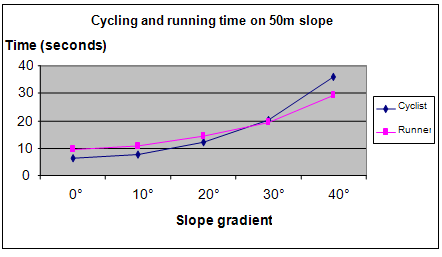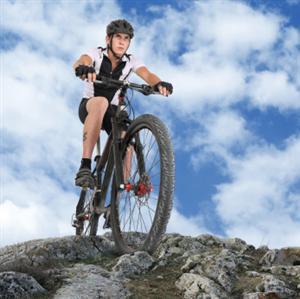| Complexity level: | 7 |
| Project cost ($): | 50 |
| Time required: | 1 hour to prepare, 5 days for the science project experiment |
| Material availability: | You can purchase an inclinometer from a bicycle hobby store or online |
| Safety concerns: | Proper safety measures for the cyclists and runners should be observed, especially when climbing steeper slopes. |
Hypothesis
As the inclination of the hill is increased, a cyclist will be slower than a runner.
Overview
Cycling
Cycling or biking is a form of transportation using bicycles. A bicycle is powered by the pedal and has 2 wheels. Other similar forms of transportation are unicycle and tricycles. These vehicles are normally used for transportation, sports and recreation. Cycle rickshaws are bicycles modified to carry passengers.
A bicycle is suitable for traveling short distances. They are human powered vehicles and therefore produce no pollution and are environment friendly. Cycling is also a good form of exercise and helps to maintain our fitness. They take up less space on the road and help to reduce traffic congestion. We can also save money on parking charges and fuel costs.
However, some criticism has been made against cycling. Concerns have been made regarding the lack of protection and safety for cyclists during an accident. Cyclists are also not protected from the pollution emitted by other passing vehicles. There is also no protection from weather elements for cyclists.
Scientific Terms
Materials
The materials required for this science project:
- 10 amateur cyclists
- 10 amateur runners
- 1 bicycle
- 1 inclinometer
- 1 flat road
- 4 hill roads at different inclination – 10 ° , 20 °, 30 ° and 40 °
- 1 stopwatch
- 1 box of white chalk
- A 100m long measurement tape
- An assistant
Procedure
1. For this science project experiment, the independent variable is the gradient of the slope - 10°, 20°, 30° and 40°. The dependent variable is the time taken by the runners and cyclists to cover the 50 meter distance. This is determined by measuring the time taken with a stopwatch. The constants (control variables) are the length of the course, the type of bicycle and the weather.
2. Ten runners and cyclists are chosen to take part in this experiment.
3. Four hills slopes are chosen for this experiment. Each course is chosen with a different gradient. An inclinometer is used to measure the gradient of the slope. The chosen slopes should have an approximate gradient of 10°, 20°, 30° and 40°. The 5th course will be a flat route with 0° gradient. The distance of each course is 50 meters. White chalk is used to mark the starting line and the finish line.
4. The 10 runners and cyclist are made to cycle and run each of the 5 courses. They will each complete one course a day. You should ensure that the weather conditions are the same for each day of the experiment. Wait a day or two, if necessary. The time taken by the 10 participants at each course is totaled and divided by 10 to obtain the average results. The average time is recorded in the table given below.

Results
It was observed that at the slope of 30° the runners and the cyclists were at almost the same speed. The cyclists were faster at slopes below 30° gradient but the runners were faster at slopes above 30°.
|
Method |
Comparing cycling and running time on hill slope (seconds) |
||||
|
0° |
10° |
20° |
30° |
40° |
|
|
Cyclist |
6.4 |
7.8 |
12.2 |
20.1 |
35.9 |
|
Runner |
9.5 |
10.9 |
14.2 |
19.3 |
29.1 |
The graph below represents the results of our science project experiment:

Conclusion
The hypothesis that as the inclination of the hill increases, cyclists will be slower than runners, is proven to be true.
Riding a bicycle on flat terrain is relatively easy to do but climbing a hill on a bicycle will require more skill and energy. With more experience and training, riding over hills gradually becomes easier. Modern mountain bikes with advanced gears also help riders to climb hills using their bicycles. Understanding different types of hills and knowing when to accelerate is important for the cyclist to climb over the hill quickly using minimum energy.
Also consider
Try to repeat the science experiment using a mountain bicycle.
The experiment can also be repeated with a 2km, or 5km hill course (a longer distance) with cyclists and long distance runners.
References
Cycling - http://en.wikipedia.org/wiki/Cycling
How to climb a hill on a bicycle - http://www.kenkifer.com/bikepages/skills/uphill.htm

